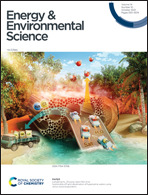Approaching a high-rate and sustainable production of hydrogen peroxide: oxygen reduction on Co–N–C single-atom electrocatalysts in simulated seawater†
Abstract
Electrochemical production of H2O2 from O2 using simulated seawater provides a promising alternative to the energy-intensive industrial anthraquinone process. In this study, a flow cell system is built for electrocatalytic production of H2O2 under an air atmosphere in simulated seawater using cobalt single-atom catalysts (Co SACs). The Co SACs can achieve a high H2O2 production rate of 3.4 mol gcatalyst−1 h−1 under an air flow at a current density of 50 mA cmgeo−2 and long-term stability over 24 h in 0.5 M NaCl. It is found that Co–N5 rather than the Co–N4 structure in Co SACs is the main active site for H2O2 formation in the two-electron oxygen reduction reaction (ORR) pathway. It also shows high chloride-endurability without inhibition of the ORR process in simulated seawater. The fast production of H2O2 on Co–N5 sites in a flow cell provides a promising path of electrocatalytic oxygen reduction in simulated seawater, eventually converting ubiquitous air and seawater towards energy sustainability.



 Please wait while we load your content...
Please wait while we load your content...